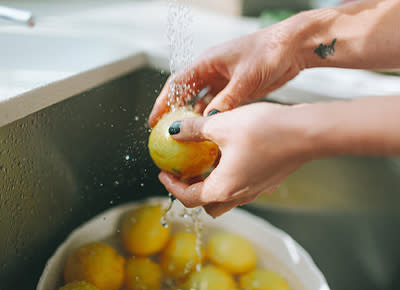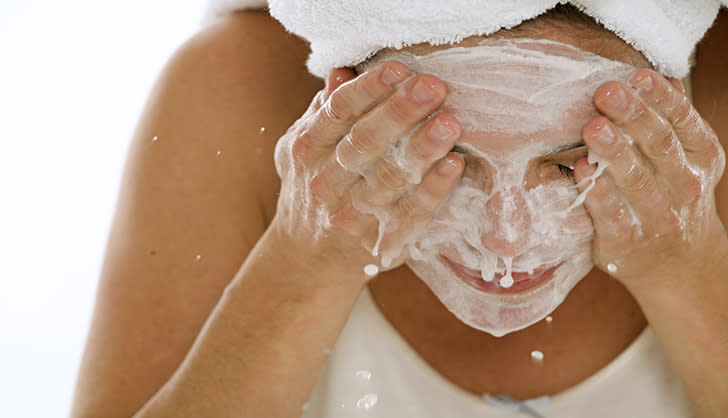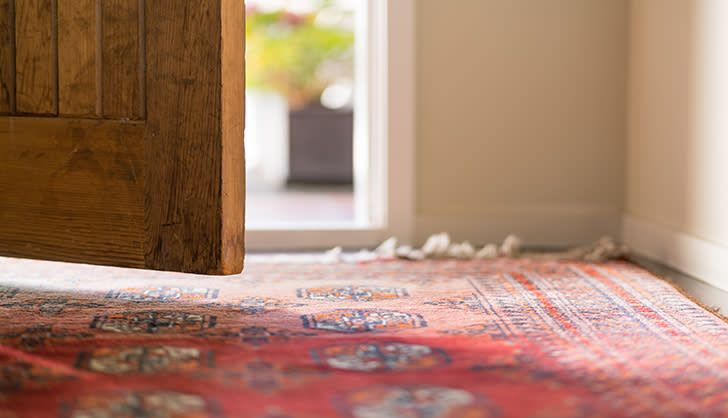7 Surprising Uses for Baking Soda

Let’s chat baking soda. Chances are you probably have a box chilling in the back of your fridge. But the white stuff, otherwise known as sodium bicarbonate, can do so much more than just absorb odors and make fluffy bread. Here are seven uses for baking soda beyond the kitchen.

1. Make a Face Mask
Yes, it’s another beauty DIY using pantry staples, but hear us out. Baking soda can be a powerful ingredient in helping declog pores and gently exfoliating—two important things for cleansing congested skin. Combine it with lemon, a skin-brightener, and honey, which has antibacterial and anti-inflammatory properties, and you have an inexpensive skin care treatment that helps soothe acne-prone complexions (something that would cost upwards of $12 even for a drugstore buy).
Baking soda face mask recipe*
Step 1. Mix 1 or 2 tbsp of baking soda with the juice from half a lemon.
Step 2. Add a squirt or two of honey.
Step 3. Combine to create a paste-like consistency.
Step 4. Apply the mixture to a clean face.
Step 5. Let it sit for about 15 minutes.
Step 6. Rinse and say hello to a glowing complexion.
*Test this combination on your arm before applying to your face to make sure your skin is not sensitive to the ingredients.

2. Clean Produce
Rid supermarket produce of pesticides—you know, those toxic chemicals sprayed on non-organic fruits and veggies to prevent insects, germs and weeds from damaging crops—by soaking them in a baking soda bath. According to a study in the Journal of Agriculture and Food Chemistry, baking soda is the most effective solution for removing pesticide residue from produce. Turns out even if you run items under tap water, you’re likely still consuming the chemicals you thought you were washing away (yikes!).
How to use baking soda to clean your produce:
Step 1. Fill a large bowl with two cups of water.
Step 2. Add 1 tsp of baking soda.
Step 3. Submerge produce for at least 2 minutes (the study found that soaking for 12-15 minutes completely removed all pesticides).
Step 4. Wash produce before eating.

3. Freshen the Air
Not to be the bearer of bad news, but if you’ve ever finished a home cleaning day by misting a “fresh linen” scent around your space, what you were actually doing was releasing a list of hazardous chemicals into the air. Yes, really! Most air fresheners—including sprays, gels, plug-ins and beads—contain concerning ingredients, notably phthalates, which are used to make plastic flexible and can potentially cause cancer. In other words, if you want to emit a scent around your home without breathing in harmful toxins, try using a mix of baking soda (which neutralizes odors) and an essential oil (like lavender or eucalyptus) for an all-natural room spray.
DIY room spray:
Step 1. Mix 2 cups water with 1 tbsp of baking soda.
Step 2. Add 15 to 20 drops of an essential oil.
Step 3. Stir together.
Step 4. Transfer to a spray bottle.

4. Treat Bug Bites
What’s not to love about backyard barbecues? Sunshine, hamburgers, outdoor games, cold beer. Oh wait, mosquitoes. Even if the citronella candles are burning, these pesky bugs somehow find a way to ruin the outdoor fun with their painful bites. Keep baking soda on hand to provide relief from itching and subside swelling so you can get back to your game of cornhole in no time.
Here’s how:
Step 1. Combine 1 tsp of baking soda with a few drops of water to make a paste.
Step 2. Dab it on to bite area.
Step 3. Let it dry and leave on until it flakes off.

5. Sop Up Oil Spills
Accidentally spill cooking oil on your kitchen rug or have an oil leak on the driveway? While your first instinct may be to grab a towel to wipe it away, this will actually make matters worse by spreading the stain. Instead, apply baking soda to absorb the extra moisture.
Here’s how:
Step 1. Use a damp washcloth (not wet!) and dab the stain to soak up excess oil;t do not rub.
Step 2. Sprinkle a generous amount of baking soda over the stain to cover it.
Step 3. Let the baking soda sit for an hour.
Step 4. Use a broom or vacuum cleaner to remove the baking soda.
Step 5. Apply an appropriate cleaning product for the material to treat the stain.

6. Clean Your Teeth
Whether you’re in a pinch, transitioning to plastic-free living or worried you don’t know half the ingredients on the back of a store-bought tube, making your own toothpaste is far less intimidating that it sounds. All it takes is baking soda (a mild abrasive that’s alkaline, which helps neutralize acid to promote a healthy mouth), coconut oil and a few drops of an essential oil to get those pearly whites shining, the all-natural way.
How to make your own toothpaste:
Step 1. Liquify coconut oil in a saucepan over low heat.
Step 2. Mix 4 tbsp of coconut oil with 2 to 4 tbsp of baking soda (the more baking soda, the firmer the paste).
Step 3. Stir in 25 drops of an essential oil (peppermint, eucalyptus, grapefruit, the options are endless).
Step 4. Pour the liquid into a lidded glass jar and store in the fridge.
Step 5. Use a spoon to apply it to your toothbrush.

7. Deodorize Your Carpet
We all know carpeting can become a collector of spills and crumbs (especially when vacuuming gets pushed back on the list of chores to “I’ll get to it next weekend”). Combined with daily foot traffic, rugs absorb all sorts of smells...and have lots of little spaces to hide them. That’s where this time-efficient trick to deodorize your carpet comes in to play:
Step 1. Vacuum the carpet to remove any debris.
Step 2. Sprinkle baking soda across the rug, which neutralizes and absorbs deep-set odors.
Step 3. Let it sit for at least an hour (the longer it spends on the rug, the better).
Step 4. Vacuum up the baking soda. Seriously, it’s that easy!
Additional reporting by Jillian Quint

